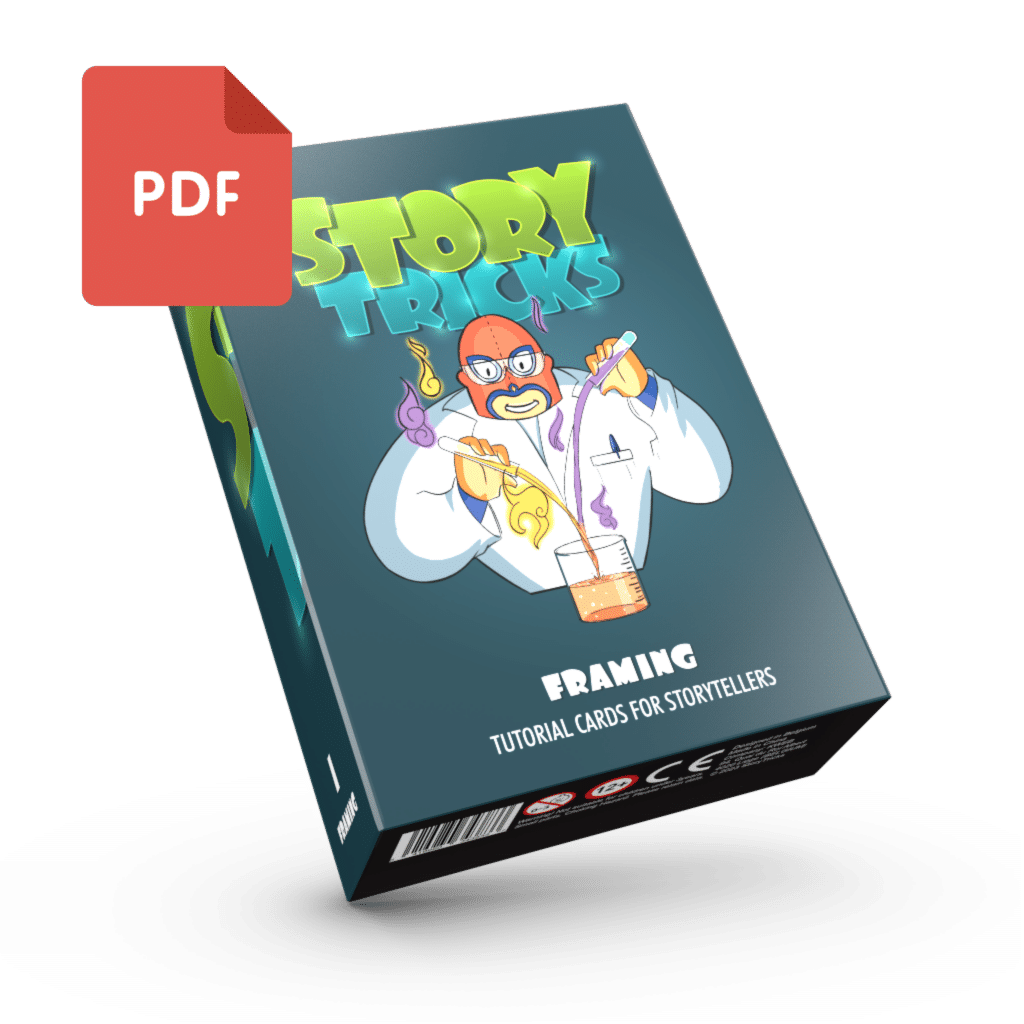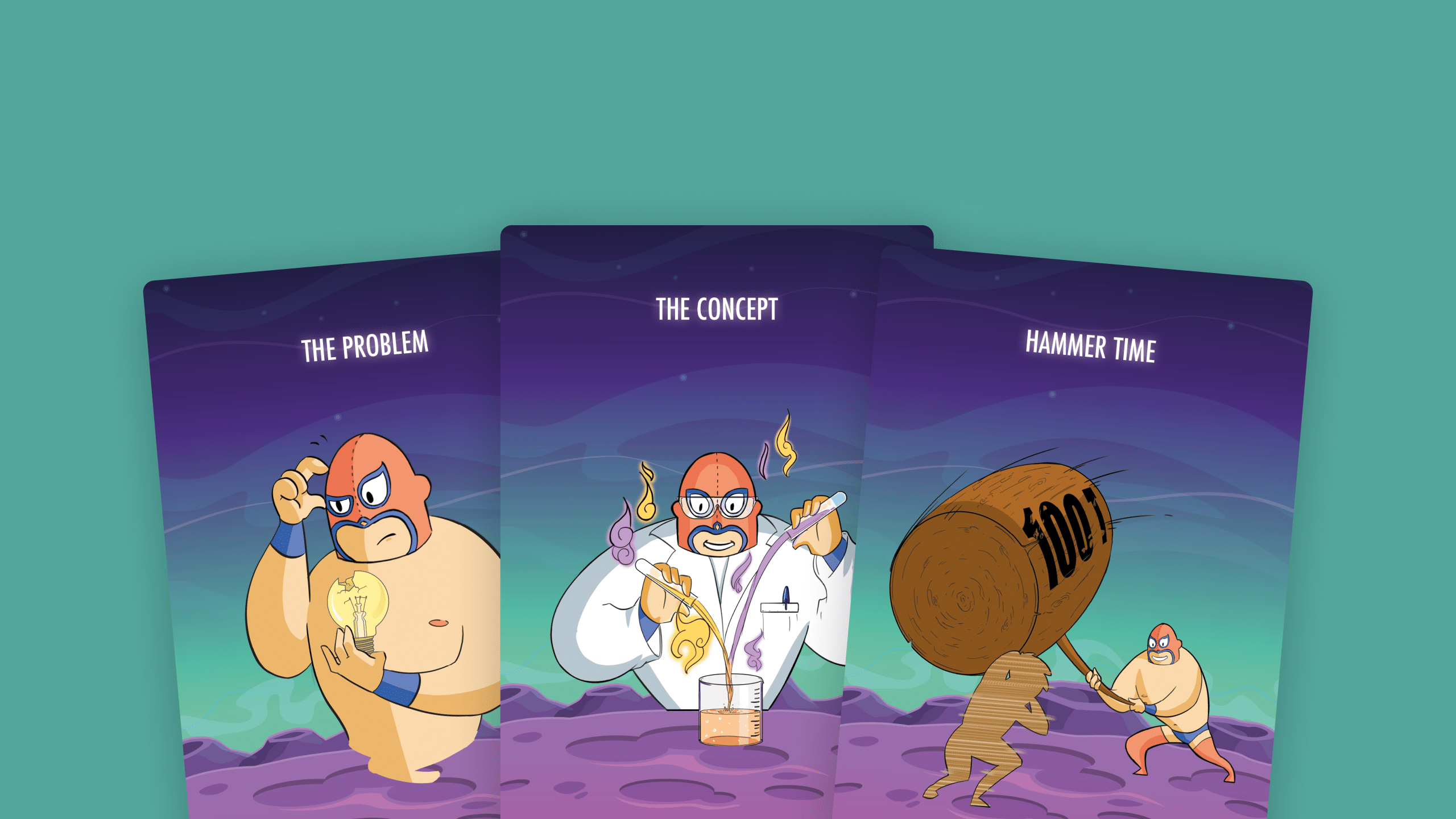Creating a story that stands out in a sea of narratives is no small feat. Whether you are a seasoned writer or just starting, the quest for originality can be daunting. The good news is, with the right tools and approach, you can craft a story that is not only unique but also compelling and resonant with your audience. This guide will take you through the art of crafting an original story using the StoryTricks system, which is divided into five powerful decks: Framing, Structure, Characters, Genres, and Empathy.
Related Deck

Framing Deck
Clarify your vision, find your concept, model your audience, craft the perfect logline, and bulletproof your pitch.
Get my free deckTable of Contents
1. Framing Your Story: Building a Solid Foundation
Before diving into the intricacies of character development or plot twists, you must first frame your story. The Framing Deck is designed to help you define the essential elements that will serve as the backbone of your narrative. Here’s how to use it:
1.1 Establish Your Story’s Purpose
Every story needs a reason to exist. Ask yourself: Why am I telling this story? What do I want my audience to feel or learn? This is the “why” of your story—its core message or theme. It could be a commentary on social issues, an exploration of human emotions, or a simple tale of adventure. The Framing Deck helps you clarify this purpose, ensuring that every element of your story aligns with your central message.
1.2 Define the Narrative Perspective
Decide who is telling your story. Is it a first-person narrative, providing intimate insights into the protagonist’s thoughts? Or is it a third-person omniscient perspective, offering a broader view of the world and its inhabitants? The Framing Deck encourages you to experiment with different perspectives to see which one best serves your story’s purpose.
1.3 Set the Stakes
What does your protagonist stand to lose or gain? The stakes are the driving force behind your narrative tension. High stakes make for a gripping story. The Framing Deck prompts you to clearly outline these stakes, ensuring that your audience remains invested in the outcome.
1.4 Establish the Setting
The setting is not just a backdrop for your story; it’s an active participant. Whether it’s a bustling city, a desolate wasteland, or a quiet village, the setting can influence the mood, tone, and even the actions of your characters. Use the Framing Deck to explore different settings and understand how they can enhance your narrative.
2. Structuring Your Story: The Blueprint of Your Narrative
Once your story’s foundation is set, it’s time to build its structure. The Structure Deck offers a comprehensive guide to organizing your story’s elements into a cohesive and engaging narrative.
2.1 The Three-Act Structure
One of the most popular storytelling structures is the Three-Act Structure, which divides your story into three parts: Setup, Confrontation, and Resolution. The Structure Deck helps you break down each act:
- Act 1: Setup – Introduce your characters, setting, and the story’s central conflict. Establish the world and set the stage for what’s to come.
- Act 2: Confrontation – This is where the bulk of the story unfolds. Your protagonist faces obstacles, makes crucial decisions, and moves closer to their goal.
- Act 3: Resolution – The story reaches its climax, and the conflict is resolved. Tying up loose ends and providing a satisfying conclusion is key.
2.2 Non-Linear Storytelling
Not all stories are best told in a linear fashion. Some narratives benefit from a non-linear structure, where events are presented out of chronological order. This can create suspense, reveal crucial information at strategic points, and keep the audience engaged. The Structure Deck offers tips on how to effectively implement non-linear storytelling without confusing your audience.
2.3 Plotting the Hero’s Journey
The Hero’s Journey is another powerful structural tool, particularly in epic tales of adventure and transformation. The Structure Deck guides you through the twelve stages of the Hero’s Journey, from the Call to Adventure to the Return with the Elixir. This structure is particularly effective for stories that focus on personal growth and transformation.
2.4 Pacing Your Story
Pacing is crucial to maintaining your audience’s interest. Too slow, and you risk losing their attention; too fast, and you may leave them overwhelmed. The Structure Deck helps you find the right balance, ensuring that your story’s tempo matches its tone and content.
3. Creating Compelling Characters: Breathing Life Into Your Story
Characters are the heart of your story. They are the vehicles through which your audience experiences the narrative. The Characters Deck is your go-to resource for developing characters that are not only believable but also unforgettable.
3.1 Building Multi-Dimensional Characters
A well-rounded character is more than just a name and a physical description. The Characters Deck encourages you to delve into your characters’ backstories, motivations, and fears. What drives them? What are their flaws? These are the questions that will help you create multi-dimensional characters that resonate with your audience.
3.2 Crafting Authentic Dialogue
Dialogue is a powerful tool for revealing character and advancing the plot. The Characters Deck offers techniques for crafting dialogue that sounds natural and reflects your characters’ personalities. Remember, what a character says (and doesn’t say) can reveal much about who they are.
3.3 Developing Character Arcs
A character arc is the transformation or journey that a character undergoes throughout the story. The Characters Deck guides you in creating arcs that are believable and satisfying. Whether your character is undergoing a positive change or a tragic downfall, their arc should feel earned and integral to the story.
3.4 Creating Memorable Antagonists
Every great story needs a formidable antagonist. The Characters Deck helps you develop antagonists that are more than just obstacles; they are fully fleshed-out characters with their own goals and motivations. A well-crafted antagonist can elevate your story by providing a worthy challenge for your protagonist.
4. Choosing the Right Genre: Setting the Tone and Expectations
The genre of your story dictates not only its style and tone but also the expectations of your audience. The Genres Deck is designed to help you navigate the vast landscape of genres and subgenres, ensuring that your story fits comfortably within its chosen category while still offering something new.
4.1 Understanding Genre Conventions
Each genre comes with its own set of conventions and tropes. Whether you’re writing a mystery, romance, sci-fi, or fantasy, the Genres Deck helps you understand these conventions so you can use them to your advantage. Knowing the rules allows you to bend or break them in creative ways, contributing to the originality of your story.
4.2 Blending Genres
Sometimes, the best stories come from combining elements of different genres. The Genres Deck encourages you to experiment with genre blending. For example, a sci-fi story with a strong romance subplot, or a horror story with comedic elements, can create a fresh and unique narrative experience.
4.3 Setting the Tone
Genre plays a significant role in setting the tone of your story. A thriller should be tense and suspenseful, while a comedy should be light and humorous. The Genres Deck offers insights into how to establish and maintain the right tone throughout your narrative.
4.4 Subverting Genre Expectations
One way to create an original story is to subvert genre expectations. The Genres Deck provides strategies for surprising your audience by playing against typical genre conventions. This can create a more engaging and unpredictable narrative, keeping your readers on their toes.
5. Creating Emotional Resonance: Connecting With Your Audience
At its core, storytelling is about creating an emotional connection with your audience. The Empathy Deck is a powerful tool for ensuring that your story resonates on an emotional level, making it memorable and impactful.
5.1 Understanding Your Audience
Before you can create an emotional connection, you need to understand who your audience is and what they care about. The Empathy Deck helps you identify your target audience’s values, fears, and desires. This understanding allows you to tailor your story to speak directly to them.
5.2 Crafting Relatable Characters
Relatable characters are key to building empathy. The Empathy Deck guides you in creating characters that your audience can see themselves in. This doesn’t mean all your characters have to be likable, but they should be understandable and relatable on some level.
5.3 Evoking Strong Emotions
Whether it’s joy, sorrow, fear, or anger, your story should evoke strong emotions in your audience. The Empathy Deck provides techniques for tapping into universal emotions through your narrative. This could be through a poignant moment of loss, a triumphant victory, or a heart-pounding moment of danger.
5.4 Creating Resonant Themes
Themes are the underlying messages or ideas that run through your story. The Empathy Deck helps you identify and develop themes that will resonate with your audience. These themes should be woven throughout your narrative, reinforcing the emotional impact of your story.
Conclusion
Creating an original and compelling story is an intricate process, but with the right approach and tools, it’s a challenge you can master. The StoryTricks system, with its five decks—Framing, Structure, Characters, Genres, and Empathy—provides a comprehensive guide to every aspect of storytelling.
- Framing helps you establish the foundation of your story, ensuring that you have a clear purpose, perspective, stakes, and setting.
- Structure gives you the tools to organize your narrative in a way that is engaging and satisfying, whether through a classic three-act structure, a non-linear approach, or the Hero’s Journey.
- Characters guides you in creating multi-dimensional, believable characters that drive your story and resonate with your audience.
- Genres ensures that your story fits within its genre while still standing out, offering fresh takes on familiar conventions.
- Empathy helps you connect with your audience on an emotional level, creating a story that is not only original but also deeply resonant.
By combining these elements, you can craft a story that is truly your own—a narrative that stands out in a crowded market, captivates your audience, and leaves a lasting impact. With StoryTricks, you’re not just telling a story; you’re creating an experience that your readers will remember long after they’ve turned the final page.
Related Deck

Framing Deck
Clarify your vision, find your concept, model your audience, craft the perfect logline, and bulletproof your pitch.
Get my free deckUseful Links
The Hero’s Journey – Mythic Structure of Joseph Campbell
Overview of Joseph Campbell’s Hero’s Journey structure.
Three-Act Structure in Screenwriting
A guide to the Three-Act Structure used in screenwriting.
MasterClass article on developing multi-dimensional characters.
https://www.masterclass.com/articles/how-to-develop-your-characters
Guide to the conventions of different literary genres.
https://writersedit.com/fiction-writing/complete-guide-literary-genres/
Non-Linear Storytelling Techniques
Article on writing non-linear narratives in film and fiction.
Tips for writing authentic and engaging dialogue.
https://www.well-storied.com/blog/how-to-write-authentic-dialogue
How to subvert genre conventions to create unique stories.
https://www.nownovel.com/blog/subverting-genre-expectations/
Guide on how to control the pacing of your novel.
https://writersedit.com/fiction-writing/pace-novel-perfectly/
Creating Emotional Resonance in Stories
Techniques to evoke strong emotions in your writing.
https://writersedit.com/fiction-writing/creating-emotional-resonance/
Story Setting and Worldbuilding
MasterClass guide to worldbuilding and setting creation.
